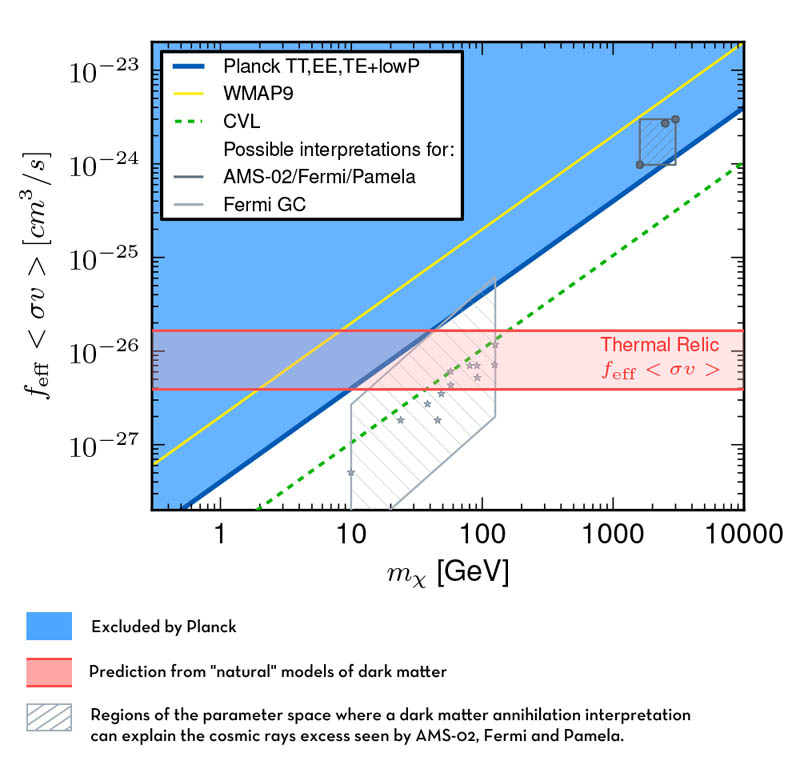LATEST PLANCK RESULTS IMPROVE OUR KNOWLEDGE ON DARK MATTER AND PRIMORDIAL NEUTRINOS
The Planck collaboration, which includes scientists and engineers from the Institut d'Astrophyique de Paris, has presented on December 1st in an international conference at Ferrara (Italy), its analysis of four years of observation by the ESA satellite, Planck. For the first time, full sky maps of the cosmic microwave background are revealed. These maps, associated to those obtained from the improved temperature anisotropies, enhance greatly our knowledge of the beginning of the Universe. This improvement is such that the collaboration is narrowing the constraints on two of the most elusive particles of our cosmological model: relic neutrinos and dark matter.
Neutrinos are incredibly light particles whose interaction with other particles are extremely weak. Large quantities of neutrinos are produced in the Sun, or other violent astrophysical processes, like explosions of stars. In order to see them and explore their properties, scientists have to build gigantic instruments, for example, by installing detectors in a cube kilometer of underground ice at the south pole! Relic neutrinos are produce just a second after the big bang. Even if we cannot detect directly those very low energy particle, they leave a weak signature in the properties of the cosmic microwave background. It's this signature that has been unambiguously observed in the new Planck data. This measurement is in agreement with the Standard Model of particle physics, and exclude a fourth family of neutrino. Planck measurement also set an upper limit to the sum of the mass of the three neutrino species down to 0.23eV, 2 million time less than the mass of an electron!
Dark matter is this unknown matter that astronomers include in their models to account for the missing mass in galaxy and clusters, when comparing with their census of visible matter. Existence of this hypothetical matter is already reinforced by the properties of the temperature anisotropies that Planck measures. Furthermore, it is necessary to explain the gravitational lensing effects measured on background galaxies, or on the cosmic microwave background. Reproducing Planck observations with baryonic matter alone would require major revisions to the theory. As such, the latest Planck measurements confirm previous Planck estimates of the density of dark matter in our Universe. With the improvement of the temperature maps, and the addition of polarization data, large scale maps of the dark matter distribution measured using gravitational lensing effect are significantly improved.
But the new Planck results bring much more information on the nature of dark matter. Indeed, numerous models try to describe the nature of this unknown matter, and important observation programs are dedicated to its detection. Recently, The Fermi and Pamela satellites, as well as the AMS-02 experiment onboard the International Space Station reported an excess of high energy cosmic rays, that can be explained in a broad range of dark matter models as the signature of intense dark matter particle-antiparticle annihilations. However, the latest Planck results exclude this hypothesis. Indeed, those annihilation would have left an important signature on the cosmic microwave background, that the latest Planck analysis should have detected. This signature is clearly absent, therefore scientists will have to find new mechanisms for explaining the cosmic rays excess.
Links
- Films (in french) "Mission Planck":
« 2013, images de l'Univers en formation », « 2014, de nouveaux
résultats », et « Planck 2014, Voir l'invisible », directed by Véronique Kleiner, produced by CNRS Images.
- Planck on Facebook (in french)
- Planck on Tweeter (in french)

Joint constraint between the number of effective species of neutrinos (Neff), the expansion velocity (Ho) and the clustering of matter today (sigma8). Coloured points gives the constraint from temperature data only. Black contours are using in addition Planck polarization data and matter clustering observations. The vertical line is the 3.046 standard model prediction which correspond to 3 neutrino families. The dashed lines correspond to 3 different scenarios that include a 4th neutrino family extension. © ESA - collaboration Planck

Dark matter annihilation constraint from Planck as a function of the dark matter particle masses. Models predicting a strong annihilation (upper part of the figure) associated to a median or low mass (left of the figure) are excluded by the new Planck results. That includes the dark matter annihilation. That also excludes the dark matter annihilation interpretation of the AMS-02, Fermi and Pamela results, as shown... © ESA - collaboration Planck

Polarization in a few regions of the sky. Only the 353GHz channel polarization is presented here. In this channel, the emission is dominated by dust in our galaxy. This allows for a much stronger polarized contrast which is easier to represent. Polarization is shown as contrasted ridges which describe its direction on top of the dust emission. © ESA - Planck collaboration, embossed design by Marc-Antoine Miville-Deschênes
December 2014
